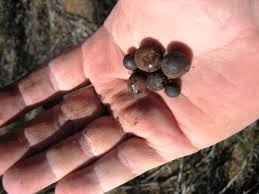On the weekend I was painting a canvas, as I often do. Even after 14 years as a professional artist I am still experimenting and trying to build a better mousetrap; I imagine I'll still be doing that when I'm 90+!
One of the materials that I specialise in and am constantly exploring is balga resin, which is hardened sap from a grass tree (Xanthorrhoea preissii, aka X. pecoris or X.reflexa) indigenous to the south-west of Western Australia. Now if anyboday wants some to conduct their own research/experimentation/painting with this then I am happy to send you some if you cover postage (please check first with your government website to make sure this isn't a banned substance in your country).
I have been trying for years to find an appropriate way to break down the resin for use as a paint without wastage or too much loss of its natural consistancy and on the weekend I think had a eureka! moment after I sprayed workable fixative over the top of some powdered balga resin already adhered to my painting. I'm not sure if it is the alcohol that is acting as a solvent or some other ingredient, but I have now experimented with a variety of amounts and achieved quite a good control of consistancy and drying time (the alcohol evaporates leaving the resin to reharden to it's natural state).
The resin in it's natural state looks like fire blackened brown pebbles. These can be gently washed in plain water to remove surface sand and char before being left to dry. When dry, use a mortar and pestle to grind the resin into a powder that can be as coarse or fine as you like. Use a mask because the resin is somewhat carcinogenic.
Using workable fixative in a glass jar, you can add the powdered resin to the fixative until you get the consistency and colour that you require. The excess powder will gather at the bottom but if left overnight in a sealed jar this will mostly be dissolved.
I also found that the solution can be mixed with molotow buff proof ink although I suggest being sparing as the ink is powerful and goes a long way. The balga resin itself is a blend of browns, yellows and reds and looks approximately like wood stain but without streaks. You will be left with a shellac like liquid that can be painted directly onto your surface. Allow to be completely dry before adding more layers.
I will add more pictures as my experimentation develops and hopefully be of help to you all!
I will add more pictures as my experimentation develops and hopefully be of help to you all!
update 23rd Oct 2013:
I really stress the importance of getting the resin as clean as possible before you start. I found that a lot of sand had been lurking in my block of resin! Also when it comes to brush cleaning, the resin can be cleaned off using more fixative, or you can do what I did and leave the brush to dry after wiping off excess; the resin will not clog the brush and will slough off when you flex the bristles.
I really stress the importance of getting the resin as clean as possible before you start. I found that a lot of sand had been lurking in my block of resin! Also when it comes to brush cleaning, the resin can be cleaned off using more fixative, or you can do what I did and leave the brush to dry after wiping off excess; the resin will not clog the brush and will slough off when you flex the bristles.





No comments:
Post a Comment